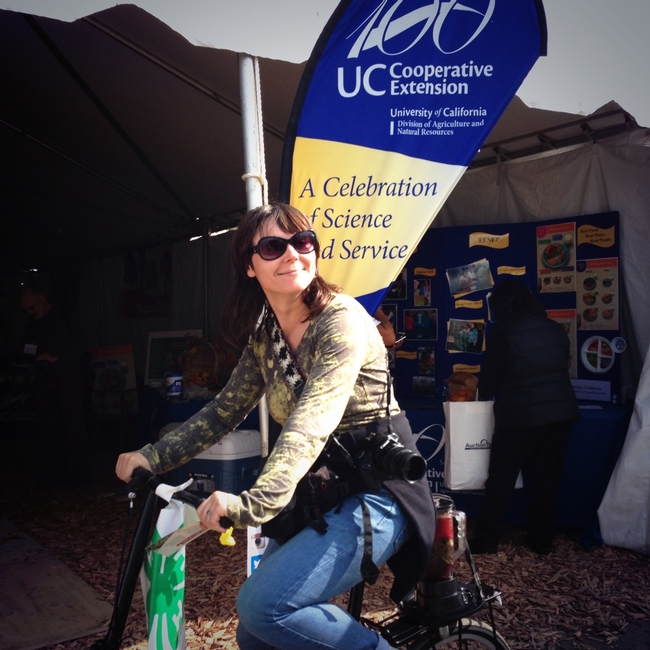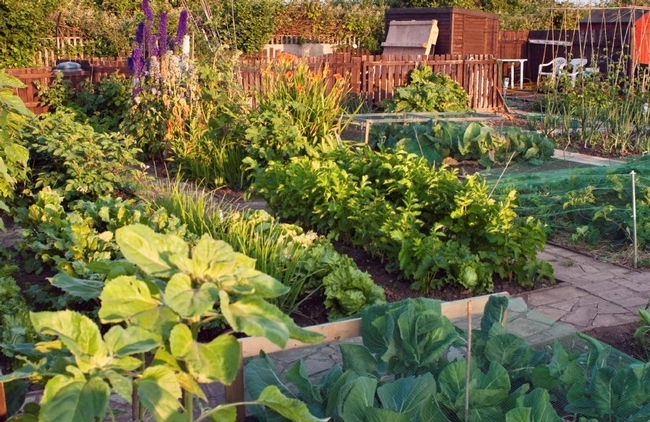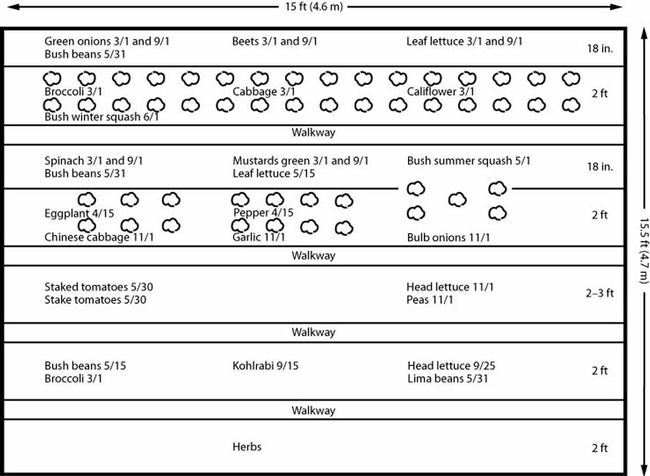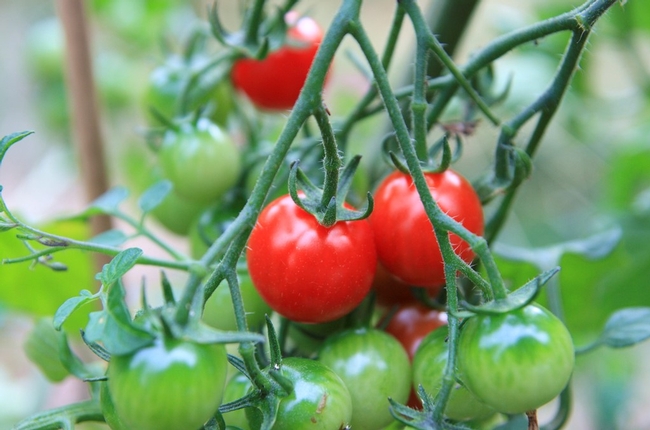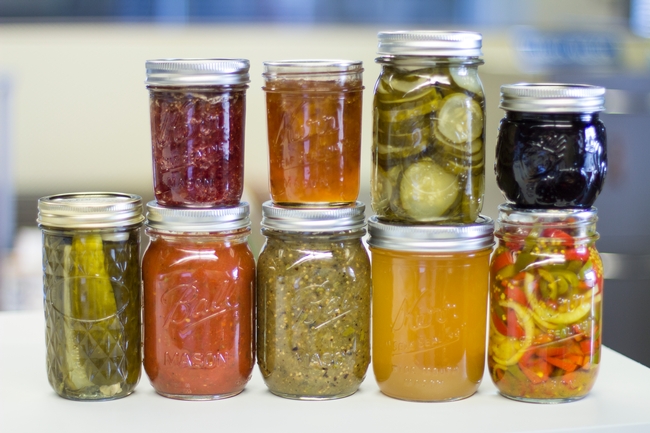UC Food and Agriculture Blogs
Eating Local - During the Drought!
You can't pick up a paper, listen to the radio or turn on the television news in recent weeks without hearing about California's historic drought. This year is shaping up to be the driest in recorded history - and even if we get rain in the 6-7...
Bike and blend your way to healthy living!
California 4-H is biking its way to healthy living. At the World Ag Expo in Tulare last week, 4-H members from across the state came to help at the California 4-H booth in the University of California Agriculture and Natural Resources tent. In honor of UC Cooperative Extension's 100th anniversary this year, California 4-H presented activities focused on healthy living.
In 2010, 18 percent of children ages 6 to17 were obese and only 15 percent of students in grades 9 to 12 nationwide met the objective for daily physical activity. Also, according to the USDA, “The quality of children's and adolescents' diets is a vital issue because poor eating patterns established in childhood may transfer to adulthood.”
The 4-H solution is to improve young people's physical fitness, nutrition habits, and socio-emotional health using a long-term, positive youth development approach. Youth are provided hands-on experiences in consumer and family sciences, personal safety, foods and nutrition, and fitness.
Research shows that this approach works. 4-H participants are 2.8 times more likely to report healthy habits.
To promote healthy living and healthy eating habits, 4-H members and visitors rode our smoothie bike to make healthy and delicious smoothies. A smoothie bike? Yep that's right, you sit down and pedal our stationary bike and on the back is a blender, the faster you pedal the quicker you make a smoothie! The smoothies were made entirely of frozen berries, bananas, fresh spinach and juice, no ice or yogurt.
Passersby were shocked at how good our smoothies were and wanted the recipe! Numerous mothers wanted to use our recipe to increase the amount of spinach in their children's diets.
See more photos on twitter (California4H) and Instagram (CA4H).

4-H program representative Sarah Watkins pushes pedals on the smoothie bike with a young visitor.

photo 3

k

ss
Slinging 'Slaw
Eat Local Placer Nevada will open its 2014 Farmers' Market tasting season this weekend with samples of our Cabbage Citrus Slaw. Many of the ingredients are locally available now, including the cabbage, carrots, garlic,...
Three winter activities for a bountiful summer harvest
Shorter days and colder weather means most people aren't thinking about spending large amounts of time in their garden. However, February is the perfect month to plant cool season leafy vegetables or root plants, like cabbage, beets and carrots. These nutrient-rich plants are packed with healthy antioxidants and vitamins and make the perfect addition to a hot bowl of soup. If you aren't game to play outdoors, cold winter months are a great time to stay inside and start planning for summer garden fruit and vegetable bounties.
If you're like most people you're probably already dreaming about summer fruits and vegetables, like tomatoes, sweet corn, blackberries and chard. Follow these three simple tips and you'll be rewarded come summertime with enough homegrown fare to fill your fridge and preserve to carry you through the year.
Step one: plan
Instead of dreaming about a summer harvest, start planning now! Don't get caught up in the seductive call of seed packets or the dreaded 'transplant trap.' This happens when you head to your local nursery without a plan for your garden and leave with 20 plants you've never heard of before.
With California in an official drought, consider planting varieties that require less water. Some great examples of drought-tolerant plants include herbs (rosemary, sage and thyme), asparagus, eggplant, melons, squash and goji berries. Think about Mediterranean flavors, many of these varieties require less water and do well in California's hot, dry climate.
Think outside the box – it doesn't have to be just about fruits and vegetables. What does your family love to eat? Do they love spaghetti? Consider focusing on a good crop of tomatoes, peppers, onions and oregano. You can harvest enough to preserve homemade marinara for the remainder of the year. Add some jalapenos to this garden mix and you have all of the ingredients for delicious salsa, another favorite that is easily preserved.
Step two: prioritize
The size of your garden will depend on available space. When planning a smaller garden, typically 10 by 10 feet or less - prioritize with fruits and vegetables that your family will eat AND that have high or continuous yields. The goal is to produce the largest quantity possible with your available resources (space, water). Great options include tomatoes, bush beans, summer squash, chard and cucumbers. In a small space, avoid crops that monopolize precious garden space like potatoes, watermelon, cabbage and artichoke. Rather, consider purchasing these tasty delights from a local farmers market.
Expand your garden's reach by incorporating edibles into your landscaping or containers. Edible landscaping is the use of food plants as design features in a landscape. Edible plants can be used both for aesthetic value as well as consumption. Blueberries, raspberries and strawberries can be expensive to buy at the supermarket, but are easy to grow at home. Visit The California Garden web for information on garden planning and individual plant spacing requirements.
Step three: prepare
Attend a UC Master Food Preserver class and learn how to manage your fruits and vegetables once they arrive from your garden and move into your kitchen. The UC Master Food Preserver (MFP) Program is a public service community outreach program focused on providing up-to-date information on food safety and preservation. Monthly classes are available, and most are free or low-cost to the public.
Preservation techniques include:
- Freezing (berries, onions, broccoli, rhubarb)
- Drying (fresh herbs, kale, root crops, peas)
- Canning (tomatoes, green beans, corn, strawberries)
Master Food Preservers have delicious recipes for salsa, corn relish, pickles, jams, jellies and much more! Winter months are the perfect time to start calendaring Master Food Preserver classes, collecting recipes and cataloging ideas for preserving your summer bounty. Find preserving research, resources or find a local UCCE Master Food Preserver class near you at on the UC Food Safety website.
With the proper planning, prioritizing, and preparation the activity level in your kitchen will be as hot as or even hotter than the temperature outside come summer harvest!
Are you interested in becoming a certified UC Master Gardener or UC Master Food Preserver? Visit our website to learn more!
A Super Bowl of Chili: 4-H'ers prepare 4-alarm chili
Making a "super bowl" of chili is also quite timely for Super Bowl Sunday on Feb. 2, when the Denver Broncos try to defeather the Seattle Seahawks.
The Solano County 4-H Program traditionally hosts a chili cookoff at its annual Project Skills Day. All clubs in the county are invited to participate.
This year three boys enrolled in an outdoor cooking project teamed to win the four-way competition, held Jan. 11 at C. A. Jacobs School, Dixon.
Cody Ceremony, Randy Marley and Justin Means, all members of the newly formed Pleasants Valley 4-H Club in Vacaville made “4-Alarm Chili,” obtaining the recipe from Justin's uncle, Chuck Means, engineer with the Sacramento Metropolitan Fire District and a co-community leader of the Dixon Ridge 4-H Club. The boys dressed in firefighter uniforms including helmets and turnouts that Means provided.
The outdoor cooking project is a joint endeavor of the Pleasants Valley and Dixon Ridge clubs.
“We simmered the chili for four hours,” Marley said of the recipe which included both pork and beef, plus four types of peppers: pasilla, serrano, anaheim and green bell.
They said it has "a little kick at the end," but not too much. The "heat" can be adjusted, depending on taste.
Judges scored the teams on temperature (it had to be 140 degrees or more), aroma, flavor, texture and freshness, plus a written recipe (neatness), and the overall presentation (table decor and costumes).
Julie Tanaka, a community leader of the Maine Prairie 4-H Club, Dixon, coordinated the event. Judges were Solano County Supervisor John Vasquez Jr. of Vacaville, Ed Coffelt of the Maine Prairie 4-H Club, and longtime 4-H'er Kathy Keatley Garvey of UC Davis/Vacaville.
"The 4-Alarm Chili was very flavorful, and the team understood the combination of ingredients - the blend of the peppers and the blend of the meats," Vasquez said.
"They all put a lot of work into it," the trio of judges agreed.
Also competing were:
- Want Quackers With Your Chili? Vaca Valley: Makenzie Davi, Marissa Davi and Emma Ryder
- Jeans ‘n Beans, Pleasants Valley: Sabrina Brown, Melanie Campilongo, Lillian Tudbury and David Witzel
- The Persim-Monsters, Suisun Valley: Alexis Taliafero, Clairese Wright and Robert Wright
The Quackers' key ingredient was - guess what! - "duck," purchased at a local market. The Persim-Monsters added persimmons to their chili, while the Jeans ‘n Beans team entered a more traditional chili.
Here's the winning recipe:
4-Alarm Chili
2 pounds of pork shoulder, cut in 1/2-inch chunks
2 pounds ground beef
Olive oil (as needed to brown meat)
2 cans of tomatoes (chopped or diced work best)
2 cans of beans (one kidney and one pinto), drained
2 pasilla peppers
2 serrano peppers
2 Anaheim peppers
2 green bell peppers
2 onions
2 cloves garlic
Water (approximately one cup)
Cornstarch
Seasonings to taste:
Beef bouillon, chili powder, ground cumin, garlic salt and black pepper.
Preparation:
In a large stock pot, brown pork in the olive oil. Add the ground beef and continue cooking over high heat until beef is browned (about 30 minutes). Add the water and seasonings. Cook an additional 30 minutes. Add tomatoes and beans. Turn down heat and simmer for 30 minutes. While mixture is simmering, coarsely chop onions and peppers and finely chop garlic. Add these to the pot and continue cooking until pork is tender (about another 30 to 35 minutes). Check flavor and add seasonings to taste. If needed, thicken chili with cornstarch.
This recipe, featuring ground duck, got high marks from the judges.
Quackers' Chili
2 to 3 pounds ground duck (the 4-H'ers purchased duck at a local supermarket; beef can be substituted)
1 to 2 large onions, chopped
6 cloves garlic, chopped
1 tablespoon dried ground cumin, or to taste
1 tablespoon dried oregano, or to taste
1 tablespoon each of chili powder and cayenne pepper (fresh chile peppers may be substituted)
Coarse salt and fresh ground black pepper, to taste
3 to 4 cups of a combination of tomato puree, tomato sauce and fresh/diced tomatoes
2-1/2 cans (14.5 ounces) of beef broth, red wine, or water can be substituted for some of the liquid (Additional broth, wine or water can be used, as needed)
1 to 2 tablespoons molasses (This helps cut down the acidity of the tomatoes. Honey may also be substituted)
1 can each of black beans and kidney beans, rinsed and drained
Condiments:
Grated cheddar cheese
Sour cream
Chopped green onions
Preparation:
in a large pot over medium-high heat, sauté ground duck, onion and garlic until meat is browned. Add cumin, oregano, chili powder, cayenne pepper, salt and pepper, tomatoes and beef broth. Reduce heat to low and simmer, covered, approximately 3 to 4 hours, stirring often. Additional broth, water or red wine may be added as needed.
Add molasses to taste. Add beans and continue to simmer another 30 minutes. Adjust seasonings to taste.
For maximum flavor, cool chili and refrigerate overnight so flavors will mellow. Chili is best made one day ahead to allow the flavors time to meld.
When ready to serve, skim top of solidified fat, reheat over low heat, and serve with cheese sour cream and green onions.
Solano County 4-H Program
Solano County has a total of 500 members in its 12 clubs. Of the seven cities in the county, Dixon has the most, with five clubs.
The clubs are:
Dixon: Dixon Ridge, Maine Prairie, Roving Clovers, Tremont, and Wolfskill
Fairfield-Suisun: Suisun Valley and Westwind
Rio Vista: Rio Vista 4-H Club
Vacaville: Elmira, Vaca Valley, and Pleasants Valley
Vallejo: Sherwood Forest
More information about the Solano County 4-H program is available from Valerie Williams, Solano County 4-H program representative, Solano County Cooperative Extension, at (707) 784-1319 or vawilliams@ucanr.edu. The website is http://cesolano.ucdavis.edu.
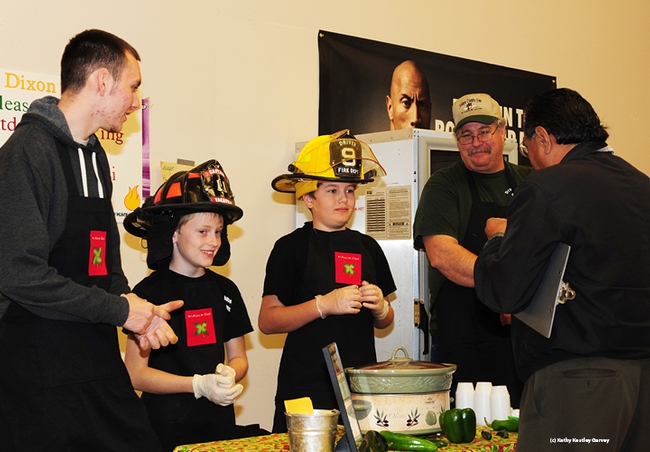
The 4-Alarm Chili Team of the Dixon Ridge 4-H Club and the newly formed Pleasants Valley 4-H Club, watches as judge John Vasquez Jr. samples their dish. From left are Randy Marley, “captain” Cody Ceremony and “driver” Justin Means. In back (at right) is Justin’s uncle, Chuck Means, who provided the recipe and the firefighter uniforms. Chuck Means is an engineer with Sacramento Metropolitan Fire District and a co-community leader of the Dixon Ridge 4-H Club. (Photo by Kathy Keatley Garvey)
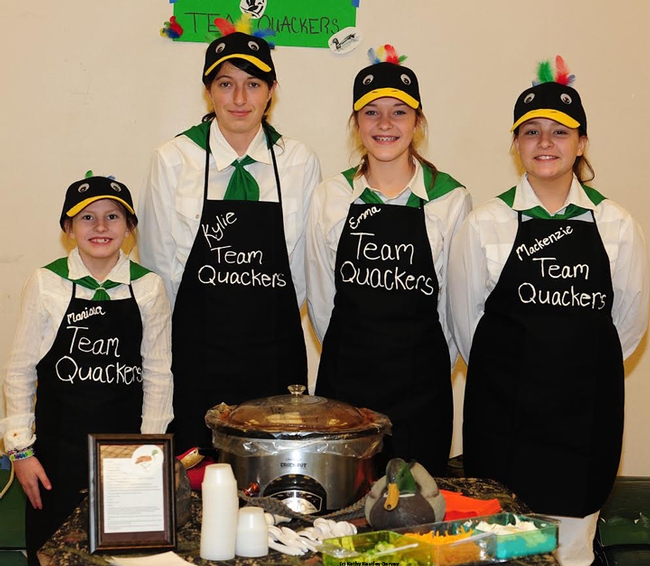
Waiting for judges at the Solano County 4-H Chili Cookoff are Team Quackers (from left) Marissa Davi, Kylie Walker, Emma Ryder and Makenzie Davi, all of the Vaca Valley 4-H Club, Vacaville. Judges praised their chili, which featured duck. For the occasion, they crafted duck hats. They were among four teams competing. The winner: the 4-Alarm Chili, the work of Cody Ceremony, Randy Marley and Justin Means of Dixon Ridge 4-H Club/Pleasants Valley 4-H Club.



